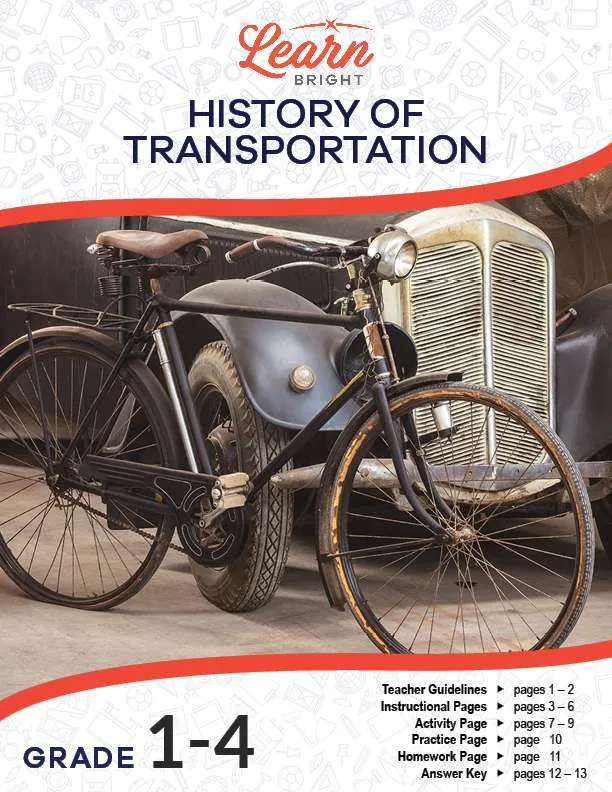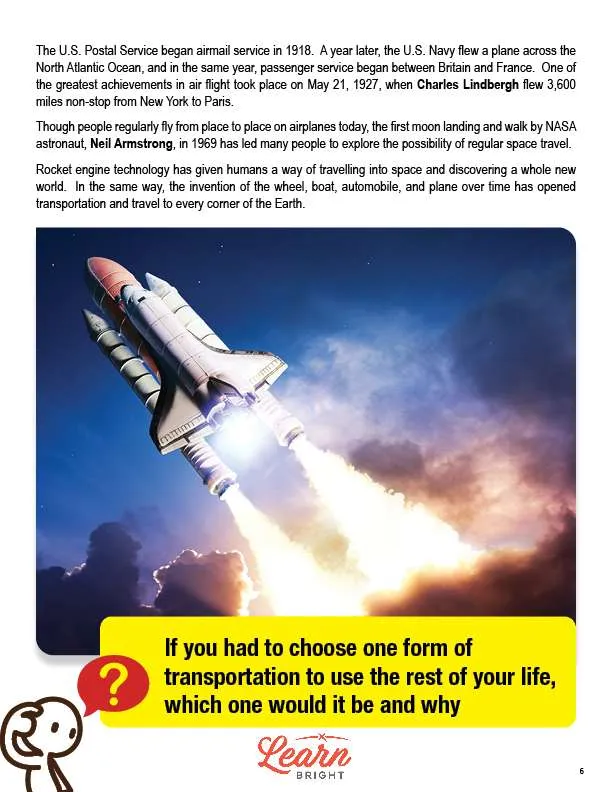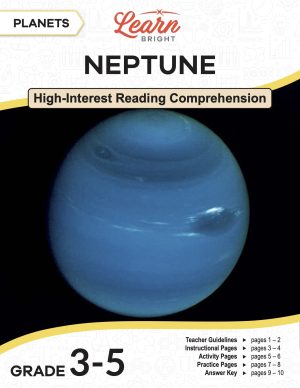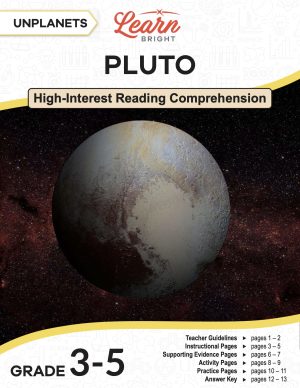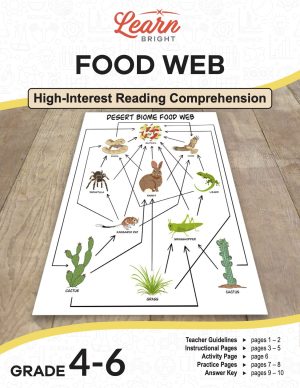Description
What our History of Transportation lesson plan includes
Lesson Objectives and Overview: History of Transportation discusses the history of transportation with the students from the invention of the wheel to future space travel. Most people, including kids, take transportation for granted and are unaware of the history behind the different methods of land, seas, and air transportation. At the end of the lesson, students will be able to define transportation, identify the modes of transportation, and describe the history of transportation methods. This lesson is for students in 1st grade, 2nd grade, 3rd grade, and 4th grade.
Classroom Procedure
Every lesson plan provides you with a classroom procedure page that outlines a step-by-step guide to follow. You do not have to follow the guide exactly. The guide helps you organize the lesson and details when to hand out worksheets. It also lists information in the orange box that you might find useful. You will find the lesson objectives, state standards, and number of class sessions the lesson should take to complete in this area. In addition, it describes the supplies you will need as well as what and how you need to prepare beforehand. The only supplies you will need for this lesson are the handouts.
Options for Lesson
Included with this lesson is an “Options for Lesson” section that lists a number of suggestions for activities to add to the lesson or substitutions for the ones already in the lesson. One optional addition to the lesson is to have your students invent a new mode of transportation, such as a hybrid (car plane), and present their idea to the class, including a sketch of their design. You could invite parents or others who rely on transportation for their careers to speak to the class, like pilots, taxi drivers, or delivery persons. Finally, you can plan a “Transportation Week” where you focus on one or two modes of transportation each day and end the week with a field trip on a bus, train, or a class bike ride if possible.
Teacher Notes
The teacher notes page includes a paragraph with additional guidelines and things to think about as you begin to plan your lesson. This page also includes lines that you can use to add your own notes as you’re preparing for this lesson.
HISTORY OF TRANSPORTATION LESSON PLAN CONTENT PAGES
Feet or Wheels?
The History of Transportation lesson plan includes four content pages. The lesson begins by asking students whether they’d prefer to get from place to place using their feet or using a vehicle with wheels. Their answers likely depend on their destination, or where they’re going. You can walk to school if you live close enough, but might need to take a bus if you live further away.
We call the method you use to travel from place to place transportation. Our original method of getting from place to place is walking. People have been walking for forever. Early modes of transport also include sitting on the back of an animal like a horse, camel, or donkey. Their legs and feet transport you from place to place.
People domesticated donkeys and horses over 6,000 years ago. This means that people tamed them and could control them. People used these animals for transportation, saving time as they traveled from place to place.
4,000 to 5,000 years ago, they also domesticated camels. They used camels like horses and donkeys, to carry people and things from place to place. To this day, people all over the world still use horses, donkeys, and camels for transportation.
Around 3,500, the people in modern-day Iraq invented the wheel. This made transportation much easier. They made the first wheels from solid pieces of wood lashed together in a circle. They didn’t use them for transportation, but as pottery wheels. At this time, camels were more efficient for travel.
Around 3,000, people started using wheels for transportation. They used them to carry goods from place to place in primitive wagons. 1,000 years later, they made wheels with spokes, seen today as one of the greatest achievements of human society.
Today, we use the wheel for many different forms of transportation. Before that, however, people started traveling by boat.
Transportation by Water
Water covers around 71% of the Earth, so people needed to find a way to travel on water. They dug early boats out of canoes built using large logs. They lit the middle of the log on fire, put it out, and then dug out the burned wood to create a hole for a person to sit inside.
The Egyptians invented the first sail boat around 3,100 and made them out of bundles of papyrus reeds. They tied the reeds together and made square sails out of sheets of papyrus. They would later make sails out of linen. At this time, they could only use the sails for traveling with the wind. When traveling against the wind, they had to row.
The Egyptians started constructing wooden ships around 500 years later. They used them to travel and trade goods with other people, steering them using long oars.
For 2,000 years, boats and ships moved using the power from oars and the wind. In 1807, a man named Robert Fulton invented the steam engine. This changed water travel forever. He built the first commercial steamboat, which used steam power to travel upstream, against the wind. Steamboats transported people and goods through rivers for many years.
One problem with water transportation was that many waterways were not connected. People built canals to connect rivers, lakes, and oceans. They built them by removing large amounts of land between bodies of water to connect them.
They built the most important canal in the U.S. in 1825, the Erie Canal. The Erie Canal is 363 miles long and connects Lake Erie to the Hudson River and the Atlantic Ocean. Another important canal is the Panama Canal, located in Central America. It connects the Atlantic and Pacific Oceans. It’s 48 miles long and they completed it in 1914.
Roads and More Wheels
As time went on, people used horses, donkeys, and oxen to pull wheeled carts, coaches, and wagons. They transported goods and people on dirt roads. In 1886, Karl Benz, a German inventor, invented a motor-run wagon. The wagons had their own engines who helped them move faster and pull more people. We consider this to be the birth of the modern automobile. Karl Benz also founded Mercedes Benz, which still exists today.
In the early 1900s, Henry Ford developed the first car in America, called the Model T Ford. It was inexpensive and could travel at speeds of 40 to 45 miles per hour. As wheeled transportation like cars and trucks improved, so did roads.
They started replacing dirt roads with gravel. In 1824, they constructed the first asphalt road in Europe. America started paving roads in the late 1800s, the first of which was Pennsylvania Avenue in Washington, D.C., where the White House. They completed the Transcontinental Highway, which ran from coast to coast, in 1913. They called it the Lincoln Highway. Today, we have roads all over the wold. They’re covered with either asphalt or concrete, which lasts for many years.
Railroads and Airplanes
Before cars but after boats, they invented the railroad. Railroads could travel wherever they built the tracks. Around 1830, they started constructing the first railroads in America. Before railroads, it took many months to travel across the United States. This changed with the Transcontinental Railroad, completed in 1869. Someone could travel from coast to coast in just a few days. People, letters, goods, and packages could all travel much, much faster.
Today, a person or object can travel across the country or world in mere hours, thanks to the inventors of the airplane, the Wright Brothers. They made the first successful flight using an engine for power.
This first flight took place in Kitty Hawk, North Carolina on December 14, 1903. It lasted 12 seconds and traveled 120 feet. This marked the beginning of air travel. Airplanes continued to improve over the next 100 years, from single-engine solo flights to the modern airline industry.
In 1918, the U.S. Postal Service began airmail service. In 1919, the U.S. navy flew across the Atlantic Ocean and passenger service began between Britain and France. On May 21, 1927, Charles Lindbergh flew 3,600 miles non-stop from New York to Paris. This was one of the greatest achievements in air flight at that time.
People regularly fly from place to place today on airplanes. In 1969, however, we had the first moon landing and walk by a NASA scientist, Neil Armstrong. People today are thinking of ways to increase the amount of space travel that people do.
Humans have been able to go to space using rocket engine technology. Similarly, the invention and improvement of the wheel, boat, automobile, and place has opened up the possibilities of travel over time.
HISTORY OF TRANSPORTATION LESSON PLAN WORKSHEETS
The History of Transportation lesson plan includes three worksheets: an activity worksheet, a practice worksheet, and a homework assignment. You can refer to the guide on the classroom procedure page to determine when to hand out each worksheet.
ADVANTAGES AND DISADVANTAGES ACTIVITY WORKSHEET
Students will work with a partner to complete the activity worksheet. Each pair will discuss the advantages and disadvantages of each type of transportation listed on the worksheet. They will think about cost, environment, time, and more.
Students may also work either alone or in larger groups to complete the activity.
MATCHING PRACTICE WORKSHEET
The practice worksheet asks students to complete three short exercises. For the first, they will match people with their inventions or descriptions. For the second, they will match things and places to their descriptions. Finally, for the third, they will describe how five things are related to transportation.
HISTORY OF TRANSPORTATION HOMEWORK ASSIGNMENT
For the homework assignment, students will first place an X next to which invention or mode of transportation was invented or developed first. They will then read a list of different types of transportation and will circle all of the types of transportation they have personally used. They will describe their experience with one of them.
Worksheet Answer Keys
This lesson plan includes answer keys for the practice worksheet and the homework assignment. If you choose to administer the lesson pages to your students via PDF, you will need to save a new file that omits these pages. Otherwise, you can simply print out the applicable pages and keep these as reference for yourself when grading assignments.

